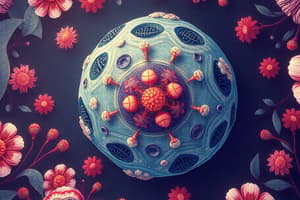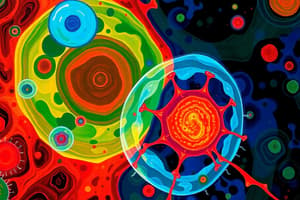Podcast
Questions and Answers
Which of the following are functions of cellular structures?
Which of the following are functions of cellular structures?
- Movement
- Secretion
- Absorption
- All of the above (correct)
What is the primary function of the nucleus?
What is the primary function of the nucleus?
Cell division and control of genetic information
The cytoplasm is a solid structure within the cell.
The cytoplasm is a solid structure within the cell.
False (B)
The process by which cells rid themselves of waste products is called ______.
The process by which cells rid themselves of waste products is called ______.
What role does the endoplasmic reticulum (ER) play in a cell?
What role does the endoplasmic reticulum (ER) play in a cell?
Which organelle is responsible for processing and packaging proteins?
Which organelle is responsible for processing and packaging proteins?
What substances do lysosomes digest?
What substances do lysosomes digest?
Flashcards are hidden until you start studying
Study Notes
Cellular Functions
- Cells perform various vital functions: movement, conductivity, metabolic absorption, secretion, excretion, respiration, reproduction, and communication.
- Movement involves generating forces for producing motion.
- Conductivity is the ability to conduct a response to stimuli, resulting in excitation.
- Metabolic absorption allows cells to intake and utilize surrounding nutrients and substances.
- Secretion involves cells releasing fluids such as mucus and saliva.
- Excretion enables cells to eliminate waste products from metabolic processes.
- Respiration is the uptake of oxygen for ATP energy transformation from nutrients.
- Reproduction supports tissue growth through cell enlargement and division.
- Communication among cells is crucial for maintaining a stable, dynamic environment.
Eukaryotic Cell Structure
- The nucleus is the largest membrane-bound organelle, typically found at the cell's center, surrounded by nucleoplasm and a double-layered nuclear envelope with nuclear pores.
- The nucleolus, DNA, and histones inside the nucleus are essential for cell division, genetic control, DNA replication, repair, and transcription.
- Cytoplasm is an aqueous solution (cytosol) comprising half the eukaryotic cell's volume, containing enzymes and ribosomes critical for protein synthesis.
Cytoplasmic Organelles
- Ribosomes: Complexes of RNA and protein, essential for synthesizing proteins, formed in the nucleolus.
- Endoplasmic Reticulum (ER): A network of channels extending from the nuclear membrane, involved in synthesizing, folding, and transporting proteins and lipids; also senses cellular stress.
- Golgi Complex: A smooth membrane network near the nucleus for processing and packaging proteins into secretory vesicles that have specific destinations, including the plasma membrane.
- Clathrin-coated vesicles are involved in transport and maintaining organelle shape.
- Lysosomes: Sac-like structures filled with enzymes that digest cellular substances into amino acids, fatty acids, and sugars; their enzymes can cause cellular damage when released during injury.
Studying That Suits You
Use AI to generate personalized quizzes and flashcards to suit your learning preferences.




